Economic Q&A with Peter Boockvar
Posted onBy David Zanca, Senior Portfolio Manager
In speaking with many of my clients over the last few months, I’ve been asked several questions about the state of the economy, the current and future prices of gold, and how you can best protect your wealth.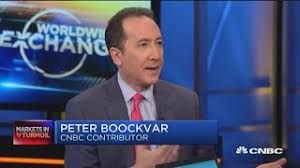
As we all can see, there is a great deal of volatility and instability in the current market environment. Inflation is at a 40-year high, significantly impacting everything from mortgage rates to grocery prices. How this affects us all, both now and in the future, is a valid concern.
To best answer your questions, I’ve once again turned to good friend of mine, Peter Boockvar. Peter and I have known each other for many years and I value and trust his advice.
Peter is the Chief Investment Officer at Bleakley Financial Group and is also editor of The Boock Report. Peter may be familiar to you as well, as he is a regular contributor on CNBC.
I’ve posed your questions to Peter, asking for his insight and his answers are below.
David: What are the key factors driving inflation higher?
Peter: Inflation over the past two years was predominantly on the goods side, notably new and used cars in addition to the rise in energy and food prices but has now been joined by an acceleration of service prices, particularly rents.
David: The Federal Reserve has stated they will aggressively hike interest rates to tamp down inflation. Will rate hikes cool inflation?
Peter: Many goods prices are beginning to cool off but that is three-fold, #1 prices got too expensive, #2 consumers bought a lot of goods over the past two years and now we’re seeing a spending hangover, #3 Fed rate hikes are slowing economic growth as well. Services inflation will though be a mitigating factor as prices here will continue to accelerate.
David: Do you see similarities in the current situation to the 2015 attempt to raise interest rates?
Peter: There is little similarity between now and 2015. The Fed hiked rates once in 2015 and only once in 2016 vs the 75 bps per meeting we are now seeing.
David: What are the negative impacts of “aggressive” Federal Reserve rate hikes?
Peter: As we’ve become a very low interest rate dependent economy and asset prices have been inflated by cheap money, a rise in the cost of capital has the potential of being highly disruptive to this environment.
David: The U.S. dollar has surged to 20-year highs against some currencies. What are the negative impacts of the stronger dollar and how is that impacting gold?
Peter: A very strong dollar should be considered a tightening of financial conditions because it negatively impacts earnings of multinationals, it hurts foreign economies that import many of their raw materials and can be negative for those foreign countries and companies that have dollar denominated debt. The US dollar strength has been an obvious headwind for gold but as gold is just another currency, it could still rally vs the dollar even if the dollar rallies against other things. This though is not currently happening as we see.
David: Why hasn’t gold performed better with inflation at a 40-year high?
Peter: It’s due to faith that the Fed will tamp down on inflation and the coincident rally in the dollar have been the major negatives.
David: What impact could sharply higher interest rates have on our record-high government debt?
Peter: The interest expense of the federal government is going to skyrocket in the coming years.
David: Much is being said of the possibility of a coming recession. How will that impact gold?
Peter: If a recession leads to a pivot from the Fed in their rate hiking cycle that would be dollar negative and likely bullish for gold.
David: Could the Fed be forced to put the brakes on rate hikes if we fall into a recession?
Peter: Yes, but only if the unemployment rate jumps notably from here to something above 5%.
David: Do you see the potential for a replay of the 1970’s period of stagflation – weak economic growth and high inflation?
Peter: We are in a stagflationary environment now and it’s a global phenomenon.
David: How long do you expect inflation to stay elevated? Are we in a new era of persistent high inflation?
Peter: We’re at or near the peak in inflation as goods prices are up at a slower pace for the 4th month in a row. Services inflation is still rising but the net result will be a peak in the rate of overall change. But a deceleration in inflation will take time and it will be years before we get back to something under 2%.
David: How could mid-term elections impact the economy/markets and gold?
Peter: Not sure if it will but if the Republicans take the House, the regulatory pressure could ease somewhat.
David: Outlook for gold/silver/precious metals?
Peter: It’s very positive if one believes that central banks won’t be able to create a soft landing for the economy. In contrast, if one has faith in the Fed and its peers, don’t own gold.
Want to read more? Subscribe to the Blanchard Newsletter and get our tales from the vault, our favorite stories from around the world and the latest tangible assets news delivered to your inbox weekly.
Central Bank Gold Purchases Climbs Third Month in a Row
Posted onIn June, central banks around the globe bought a total of 59 tonnes of gold to add to their vaults. In June, there were no central bank sales as governments hung onto the gold they already own. June marked the third consecutive month in which central banks bought ever larger amounts of gold to add to their coffers.
governments hung onto the gold they already own. June marked the third consecutive month in which central banks bought ever larger amounts of gold to add to their coffers.
Why do central banks buy gold? The same reason that you do. Central banks buy gold for a number of reasons including:
1. Gold has no counter-party risk. There is no bank, brokerage, government (in the case of bonds) that is on the other side of your trade. Owning gold gives central banks and you true ownership of a physical tangible asset that can be exchanged for paper currency in any country in the world. You never have to worry that a bankruptcy or default will cause your gold’s worth to go to zero – unlike a stock, or even a bond.
2. Gold offers diversification away from paper currencies. Central banks also own lots of paper currency – like U.S. dollars, the euro, the Chinese yuan and other fiat currency. However, owning physical gold offers central banks diversification and protection against fluctuations, devaluations and even default in paper currency. Unlike paper currency, governments can’t affect the value of gold through printing presses.
3. Gold is a store of value. History has proven that gold is a vehicle to preserve and protect wealth. It is also an inflation hedge, which allows central banks and individual investors to protect their wealth when inflation erodes the value of your paper currency.
4. Gold performs well during crises. Gold historically rises in price – usually a lot – during geopolitical or economic crises. It helps protect portfolio losses in times of market stress as it acts as a high-quality and tail risk hedge. Central banks are looking to protect their country’s wealth, just like you seeks to protect your own.
5. Gold ownership helps central banks manage risk more effectively. Gold ownership helps manage risk and volatility, through diversification. Gold has a low correlation to key asset classes including its low correlation to stocks, especially during times of heightened equity market stress.
Who’s been buying gold this year?
Turkey was the largest gold buyer in the first half of the year, adding 63t to its gold reserves, according to the World Gold Council. Egypt was the second largest buyer in the first half of 2022, with a whopping a 44t (+54%) increase in March. The country now holds 125t of gold, or 21% of total reserves, the World Gold Council said. Other major gold buyers this year included the Central Bank of Iraq India, Ireland and Ecuador.
If central banks are still buying gold, it could make you wonder, do you own enough?
Want to read more? Subscribe to the Blanchard Newsletter and get our tales from the vault, our favorite stories from around the world and the latest tangible assets news delivered to your inbox weekly.
The Fleeting History of the Fugio Cent
Posted on — 3 CommentsNo coin more perfectly represents the passage of time than the Fugio Cent. The coin, sometimes called the Franklin cent, is a work from Benjamin Franklin.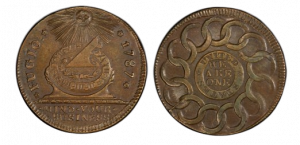
An inscription on the obverse reads “fugio” which is Latin for “I flee,” referring to the common adage that time flies. This is a fitting sentiment for a coin that was minted for only one year in 1787. The same side shows a bright sun with rays shining down on a sundial. Another inscription on the bottom reads “Mind your business” urging Americans to focus on their affairs in much the way Franklin did as a devoted entrepreneur.
The coin has the distinction of being the first circulation coin in the US. In 1787, the Congress of the Confederation of the United States authorized the creation of a copper penny that would eventually become the Fugio Cent. Franklin took inspiration from the 1776 Continental dollar that was minted in pattern pieces but never circulated.
The reverse has an image of linked rings meant to represent the unity of the original thirteen colonies with the motto ‘We are one” in the center.
The total quantity of Fugio Cents minted was relatively low at just 400,000. Ultimately, several thousand coins were stored in the basement of the Bank of New York in 1788. Almost 70 years later the same coins were packaged into cotton bags and stored for a second time. In 1926 the coins were rediscovered at which point they were distributed as souvenirs to customers and various officials. Several were sent to the American Numismatic Society. Today approximately 819 are in storage at the bank.
Research suggests that there are fifty-five varieties from twenty-four obverse dies and thirty-three reverse dies. The difference in these variations can be found in the style of sun rays on the obverse. Some versions have fine pointed rays while others have rays that are more club-shaped.
The historical significance of the Fugio Cent is more than its imagery or the fact that Franklin designed them. Consider that the copper used to mint the pieces was originally used in the bands used to hold together powder kegs provided by the French government to the United States during the American Revolution.
Today the coin remains a highly sought-after piece by collectors. In fact, some collectors seek out a rare variety called the “New Haven Restrike” which consists of both copper and silver. Some postulate that the Scovill Manufacturing Company struck these pieces in Waterbury, Connecticut. These versions are usually identified by the “G” in the word fugio. The original Fugio Cent uses a “C” with a straight line and a cross added to create the letter “G.” The New Haven Restrike, however, uses a cross stroke that only extends outward. Additionally, the linked rings are thinner on the New Haven Restrike.
The Fugio Cent is a must for anyone seeking a complete collection of coins that represent the formation of the US. The motto, creator, and even the source of the material all have origins in some of the most iconic aspects of our history.
Want to read more? Subscribe to the Blanchard Newsletter and get our tales from the vault, our favorite stories from around the world and the latest tangible assets news delivered to your inbox weekly.
Gold Rises After Fed Rate Hike as Inflation Sizzles at 40-year High
Posted onThe Federal Reserve hiked interest rates by .75 basis points Wednesday afternoon, pushing the Fed fund rate to 2.25-2.50%. This marks the fourth-rate hike by the central bank 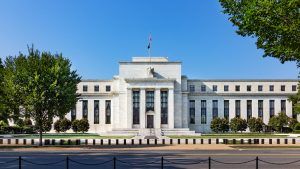 this year. Yet, as CPI inflation ratcheted to another fresh 40-year high at 9.1% in June, it is evident that the Fed is losing its battle in the fight against inflation.
this year. Yet, as CPI inflation ratcheted to another fresh 40-year high at 9.1% in June, it is evident that the Fed is losing its battle in the fight against inflation.
Spot gold climbed after the Fed announcement, recently changing hands at $1,737 per ounce. Gold has been gaining in recent days, climbing from a recent low of $1,693 on July 20. Long-term investors saw the retreat under $1,700 an ounce as an excellent buying opportunity, especially as the weakness in the U.S. dollar means you get more gold for your dollars right now.
In today’s post-meeting news conference, Federal Reserve Chairman Jerome Powell stated he doesn’t believe the U.S. economy is in recession. However, investors may be wise to take this analysis with a grain of salt, given the central bank’s insistence that 2021 inflation would be “transitory.”
Second quarter gross domestic product (GDP) data is due out on Thursday. A negative reading would fulfill the “rule of thumb” definition of a recession, which is: two consecutive quarters of negative GDP growth. In Q1, the U.S. economy shrank by 1.6% and the Atlanta Federal Reserve gauge has projected an economic decline of about the same amount for Q2.
In today’s economic environment – with the stock market firmly in a bear market and inflation at 40-year high – it reminds us that there are things we cannot control. However, investors should focus on what they can control, including portfolio allocations that protect and hedge your hard-earned wealth.
With the S&P 500 down 15% year-to-date, and the U.S. Government Fixed Income Index down 10% year-to-date, gold is one of the best performing asset classes of 2022, with a 4% decline.
Holding gold today is once again providing proven support to your portfolio – reducing overall draw-down levels and providing diversification against non-correlated paper assets. Economists are forecasting renewed weakness in the U.S. dollar later this year, as the Fed faces the reality that it will need to pull back on rate hikes to support the weak economy. And that will open the door for gold to power sharply higher, especially as inflation remains at red-hot levels.
Indeed, Goldman Sachs recently raised its year-end gold price target to $2,500 an ounce. For long-term investors, the current levels in gold offer an attractive buying opportunity. If you are considering increasing your allocation to gold, now is the optimal time to enter before the next powerful up leg in gold prices.
Want to read more? Subscribe to the Blanchard Newsletter and get our tales from the vault, our favorite stories from around the world and the latest tangible assets news delivered to your inbox weekly.
Do You Know Your Great-Great Grandmother’s Name?
Posted onAnswer quickly: what are your great-great grandparent’s names? If you don’t know, you aren’t alone. The reason I ask is that when you get to a certain age in life, some people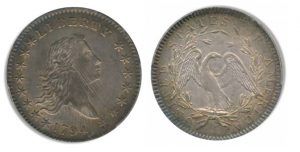 begin to consider their legacy and how they will be remembered throughout the generations of your family that will come after you.
begin to consider their legacy and how they will be remembered throughout the generations of your family that will come after you.
We live in an era where time moves fast. In a few short decades, we’ve seen the introduction of the Internet, Google, iPhones, texting and all sorts of technology that has sped up our lives.
For tangible asset investors, building a numismatics portfolio is an opportunity to slow down time, to assemble a collection of rarities that represent our nation’s history throughout time measured in hundreds of years, as opposed to nanoseconds. It is an opportunity to build a legacy that can be treasured by your children, your grandchildren and your great-grandchildren.
When Blanchard places a significant rarity with a collector, they became not only an investor but a preservationist of American history and safe keeper of the beginning of our nation’s monetary system. These legacy investments not only preserve and increase wealth, but also preserve and honor United States history.
Here’s a snapshot of a few of the flagship rarities we’ve placed in 2022.
The 1794 Flowing Hair Dollar
The 1794 Flowing Hair Dollar was the first dollar coin issued by the newly established United States federal government and represents the beginning of the American monetary system.
 The 1808 $2½ Capped Bust (Quarter Eagle)
The 1808 $2½ Capped Bust (Quarter Eagle)
Collectors call the 1808 $2.50 Capped Bust a “stopper coin.” (Stoppers are the coins that present the greatest difficulty in completing a set.) From the day this Quarter Eagle was minted it was a rarity, with only 2,710 coins produced. The few collectors who are fortunate to own this 1808 Quarter Eagle have the most sought-after coin to complete their set.
 The 1848 $10 Liberty Proof
The 1848 $10 Liberty Proof
Only two of these coins are known to exist. One is not available for private ownership and is safely ensconced at the Smithsonian, as a highlight of their National Numismatic Collection. The coin Blanchard placed has an impressive pedigree and had previously been part of the John J. Pittman Collection, one of the most famous numismatic collections of all time. The $10 Liberty Head No Motto was minted from 1838-1866.
Leaving your legacy: it’s personal
Perhaps one of the best aspects about building a collection of tangible assets to pass down to your loved ones is that it’s personal. Numismatic collections are unique and one of a kind. They represent not only significant wealth and value – but also United States history, your passions and, ultimately, are a reflection of you and your hand-picked choices over time. Hand-picking coins for your heirs allows you to leave your signature on your estate in a much more meaningful way than passing down a brokerage account.
Another benefit of leaving your legacy through a numismatic collection is the private transfer with little to no paperwork. Owning rare coins or gold bullion is a simple and private method to transfer wealth to whomever you choose. If you have a bank safe deposit box or a home safe, you can simply leave instructions or inform your family where to find and retrieve your coins or bullion. Simply put, whoever holds it, owns it.
Blanchard continues to make numismatic history with its flagship placements. We can help you build your legacy too, and help you create a collection that your great-great grandchildren can appreciate. Anyone is capable of building a long-lasting collection of significance, no matter your budget. If you’d like to explore options to meet your personal goals, risk-tolerance level and budget, please contact a Blanchard portfolio manager today.
Want to read more? Subscribe to the Blanchard Newsletter and get our tales from the vault, our favorite stories from around the world and the latest tangible assets news delivered to your inbox weekly.
It’s the Dollar, Stupid
Posted onThe 1992 presidential campaign slogan, “It’s the economy, stupid,” reflected the Democratic contender’s view that the Republican incumbent was out of touch with the 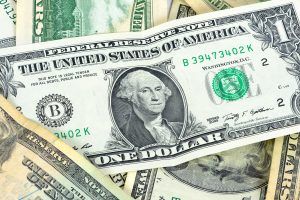 economy. Bill Clinton ultimately did prevail against George H.W. Bush in that contest.
economy. Bill Clinton ultimately did prevail against George H.W. Bush in that contest.
Investors today may be wondering why gold isn’t performing better – especially with inflation at 40-year highs and a potential recession looming on the horizon. With all due respect and no insult intended, we gently remind investors “It’s the Dollar, stupid.”
The rising U.S. dollar has been a weight on gold throughout 2022 – as the greenback climbs to its highest level in decades. Aggressive action from the Federal Reserve to hike interest rates to combat inflation has sent the U.S. dollar soaring against all the major currencies including the Japanese yen, the British pound sterling and the euro.
Measuring dollar strength
The key measure economists use to gauge the dollar’s strength is a basket of currencies that includes our major trading partners like Japan and the Eurozone. Using that measure, the U.S. dollar has climbed to a 20-year high, while the U.S. dollar spot index itself has climbed 12.6% this year.
What’s more, recently, the yen slid to a 24-year low against the U.S. dollar and the euro retreated to parity – or a one-for-one exchange rate – the first time since 2002.
For U.S. investors, this makes gold look cheap.
For foreign buyers of gold, however, the precious metal has become extremely expensive. In fact, this year, the price of gold – priced in Japanese yen hit an all-time record high.
While gold is down about 6%, priced in U.S. dollars, the commodity sector remains the best performing asset class of 2022. This year, all five equity asset classes registered double digital declines, yet the Bloomberg Commodity Index posted a 13.4% increase through mid-July.
What does this mean for you? For precious metals investors, the recent retreat in gold prices means you will receive more gold for your dollars if you buy precious metals now.
Looking ahead, the Federal Reserve may be forced to abandon its aggressive interest rate hike campaign if the U.S. economy falls into recession. That could open the door for the U.S. dollar to pull back and for gold to climb in the second half of this year. Indeed, Goldman Sachs recently raised its year end gold price target to $2,500 an ounce. For long-term investors, the current levels in gold offer an attractive buying opportunity. If you are considering increasing your allocation to gold, don’t delay, economic conditions are changing rapidly in today’s marketplace.
Want to read more? Subscribe to the Blanchard Newsletter and get our tales from the vault, our favorite stories from around the world and the latest tangible assets news delivered to your inbox weekly.
Three Reasons the U.S. Mint Produced This Odd Denomination
Posted onThree-cent pieces were first produced in silver in 1851 to help smooth the simple act of buying a postage stamp, which cost three cents at the time. The odd denomination was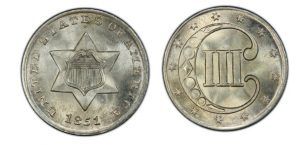 also seen as a solution for merchants to easily make change for some of the foreign coins that were still legal tender in our country.
also seen as a solution for merchants to easily make change for some of the foreign coins that were still legal tender in our country.
Then, the Civil war broke out. The war impacted nearly every aspect of American life during its tumultuous years, including the economy. To protect against the economic turmoil that the war created, Americans of means began hoarding silver coins – including these silver three-cent pieces.
After the war ended, silver coin hoarding continued. The simple act of making change, or purchasing those three-cent stamps proved challenging.
To combat these problems, Congress passed legislation in 1865 that authorized the production of three-cent pieces comprised of 75% copper and 25% nickel.
James B. Longacre, the Chief Engraver of the U.S. Mint, designed the new Nickel Three-Cent piece to mimic the look and appearance of a silver coin. The Nickel Three-Cent piece featured a color that was more white than brown. Longacre also chose to enlarge the size of the Nickel Three-Cent piece over the existing three-cent silver coin (there had been complaints the silver coin was too small).
Nickel Three-Cent pieces were minted from 1865-1889 at the Philadelphia Mint. Over 30 million Nickel Three-Cent pieces were produced in that 24 year period. After 1889, the Treasury melted down millions of them to create the new five-cent Liberty Head Nickels.
Collectors today remain intrigued by this odd denomination coin – especially around the years in which only proofs were struck: 1877, 1878, and 1886. Other dates including 1883, 1884 and 1885 are represented by tiny mintages of 4,000, 1,700 and 1,000 respectively.
Given the Treasury’s melting campaign and limited mintages of some years, these odd Nickel Three-Cent pieces create unique opportunities for collectors who aspire to own coins from the post-Civil war period in our country.
Want to read more? Subscribe to the Blanchard Newsletter and get our tales from the vault, our favorite stories from around the world and the latest tangible assets news delivered to your inbox weekly.
Will the Fed Be Humble and Nimble When It Comes to Recession?
Posted onThe Federal Reserve launched onto center stage this year when it delivered its biggest interest rate hike in decades to combat surging inflation. While U.S. interest rates are rising now, the central bank kept interest rates at zero percent coming out of the Covid crisis.
In fact, while inflation climbed steadily higher in late 2021 into early 2022 – and you were paying more for everything from gas to groceries – the Fed sat on the sidelines. Indeed by the time the Fed first hiked interest rates in March 2022, the Consumer Price Index had already hit 8.5% – well above the Fed’s stated target of inflation at 2%.
Many believe the Fed simply kept monetary policy too loose, for too long – and the 40-year high inflation is now the result.
The Federal Reserve is tasked with a so-called “dual mandate” to pursue both maximum employment and price stability. It uses its monetary levers (including raising and lower interest rates) to help achieve those goals.
Coming out of the Covid crisis, the Fed repeatedly said it expected inflation to be “transitory” – yet a variety of factors conspired to extend inflation’s presence (Russian war in Ukraine, supply chain issues and more). As the economy recovered from the Covid recession, the Fed made a choice to favor its goal of maximum employment and stated a willingness to allow inflation to exceed its target to help ensure that all Americans who wanted jobs could find them.
Yet, many believe the Fed made an inflation policy error and the central bank was just simply late to attack the red-hot trend of rising consumer prices. Now, higher prices have already become entrenched in the economy.
The Fed has already made one mistake this year. Are they set to make another?
The Fed is currently on a path to sharply raise interest rates to try to tamp down interest rates, but that means it could cause another economic problem: a recession.
Some on Wall Street are wondering if the Fed will indeed be “humble and nimble” when it comes to raising interest rates as Fed Chair Jerome Powell stated in January. Will the central bank recognize the economic pain a recession will levy on Americans who are already facing 40-year high inflation levels? Or will the Fed continue on their path and cause a recession.
Gold is expected to begin a new advance in the second half of the year, fueled by worries about recession and the on-going high inflation environment. The Federal Reserve has created a unique economic brew that we haven’t seen since the 1970’s – economists call it “stagflation” or a period of weak economic growth and high inflation.
While you can’t control the Fed or the economy, you can take action to protect and hedge your investments in these extraordinary times. Gold is the best stagflation performer since 1973 with a 12.8% annualized return, according to a Gold Hub investment update.
“Real assets do well during stagflation, with commodities both fueling and feeding off inflation, while gold has tended to benefit from the elevated risk environment, rising inflation, and a lowering of real interest rates. Gold’s strong returns come despite a stronger US dollar typically seen during stagflation,” Gold Hub said.
Goldman Sachs recently raised its year end gold price target to $2,500 an ounce. The next leg up in the gold market appears to be right around the corner.
Want to read more? Subscribe to the Blanchard Newsletter and get our tales from the vault, our favorite stories from around the world and the latest tangible assets news delivered to your inbox weekly.
Gold Loves Bad News
Posted onUnfortunately, many investors today see plenty of bad news no matter where they look.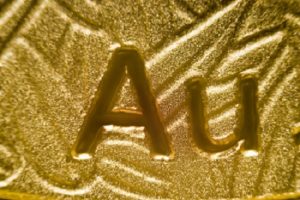
Consequently, more people are considering how an investment in gold can buoy their portfolio. For this reason, it is important to understand the nature of gold during periods of economic uncertainty. Research published in the Journal of Banking & Finance offers some answers.
The researchers explored a 30-year period spanning 1979 to 2009. Their findings reveal one simple truth: “gold loves bad news.”
However, their work also underscores some of the unseen characteristics of gold in a crisis. These are three key takeaways:
Gold Tends to Work Best as a Haven in Developed Countries
The researchers note that “gold was a strong safe haven for most developed markets during the peak of the recent financial crisis.” However, the effect is less pronounced in emerging markets. Despite this difference the researchers conclude that gold “has the potential to act as a stabilizing force for the global financial system by reducing losses when it is most needed” because the haven effect is present not only in the US but also in Eurozone markets. The researchers also offer one hypothesis that might explain the reduced safe haven effect in emerging markets. They suggest investors likely liquidate their emerging market investments during periods of declining performance and purchase equities in developed markets instead.
The Word “Haven” Is Frequently Misunderstand
The word “haven” and “hedge” are sometimes used interchangeably. The differences between the two, however, are considerable. The researchers explain that a hedge is an asset that is negatively correlated with another asset in the same portfolio on average. This description is different than a haven asset which is also negatively correlated with another asset in a given portfolio but only in certain periods like a downturn. What this distinction tells us is that the two words represent two different periods. A hedge relates to the long term, while a haven relates to the short term. When forming an investment selection, it is important to be aware of this difference when an asset is labeled as either a hedge or a haven.
Specific and General Uncertainty Have Important Distinctions
Most market uncertainty can be classified as either “specific” or “general.” Specific uncertainty emerges from a narrowly defined event. In contrast, general uncertainty refers to any uncertainty that is not connected to one particular event. This difference matters because the researchers focused their study on gold movements during periods of general uncertainty. They learned that a rise in general uncertainty often increases investor interest in gold. However, when this uncertainty becomes extreme, gold has a higher probability of moving in the same direction as equity markets.
The evidence is clear…gold plays a valuable role in a portfolio designed to weather the unforeseen and periods of uncertainty. Investors should take the time to understand the nuances of gold’s performance during downturns in equity markets. The country, the duration, and the type of uncertainty are all important factors.
Want to read more? Subscribe to the Blanchard Newsletter and get our tales from the vault, our favorite stories from around the world and the latest tangible assets news delivered to your inbox weekly.
Gold Delivers on Its Enduring Status as a Safe-Haven
Posted onUsing a baseball analogy, 2022 threw Americans a lot of curve balls that no one was expecting. We’ve seen gasoline rocket above $6 a gallon, mortgage rates soar from 3% last year to 6% today and the stock market tumble over 20%. Everyday goods simply cost more with inflation at a 40-year high. The cryptocurrency market collapsed – with  Bitcoin falling from over $67,000 in late 2021 to just over $17,000 last week.
Bitcoin falling from over $67,000 in late 2021 to just over $17,000 last week.
Amidst the market turmoil, gold has delivered as a solid safe-haven investment – and is one of the year’s best performing asset classes.
Gold is up about 1% in late June – and is holding up vastly better than other assets classes which are down a staggering 20% to 70% from their peaks.
This is a reminder of why allocating a portion of your portfolio to gold pays off. Investors who own gold have seen more stability in their portfolio, with less drawdowns than those without gold exposure. Gold is acting as a store of value to protect your wealth.
With the S&P 500 now officially in a bear market, Wall Street analysts are warning the stock market rout could still get worse before it gets better. Société Générale issued a research note this week stating that if the Federal Reserve fails to tame inflation an economic recession could push the S&P 500 down another 33%.
And what about gold? Increasing your allocation to gold now is an option to preserve and protect your wealth.
One of the factors holding the gold market steady right now – is the strong U.S. dollar. Gold and the dollar often trade inversely – so the current strength in the dollar is a headwind for the precious metals. The U.S. dollar index is up around 9% year-to-date.
However, eventually the dollar rally will stall and “that is when the gold price will take off,” Will Rhind, founder and CEO of ETF provide Granite Shares told Barron’s.
Indeed, earlier in June, Goldman Sachs released a new report stating: “We expect a rebound in emerging market gold demand in the second half of the year. In the absence of a large liquidity shock, we view current gold price weakness as a good entry point.”
Do you have cash on the sidelines ready to go to work? Preserve and protect your wealth with gold. Goldman Sachs issued 3- and 6-month targets at $2,100 and $2,300, respectively. In 12 months, the bank expects gold to reach $2,500.
Precious metals are an insurance policy that has consistently paid off for investors in all types of market cycles, and we are seeing that happen again today.
Want to read more? Subscribe to the Blanchard Newsletter and get our tales from the vault, our favorite stories from around the world and the latest tangible assets news delivered to your inbox weekly.








